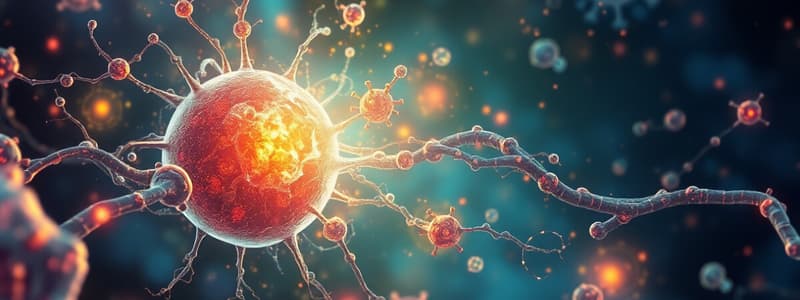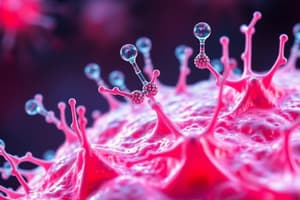Podcast
Questions and Answers
What is the primary function of glucagon in relation to blood glucose levels?
What is the primary function of glucagon in relation to blood glucose levels?
- Inhibits glycogen breakdown
- Decreases gluconeogenesis
- Stimulates insulin secretion
- Increases blood glucose levels (correct)
What stimulates the secretion of glucagon?
What stimulates the secretion of glucagon?
- Increased insulin levels
- Decreased catecholamine levels
- Elevated blood glucose
- High levels of amino acids (correct)
Which of the following statements regarding insulin action is correct?
Which of the following statements regarding insulin action is correct?
- Changes in enzymatic activity take seconds
- Increased glucose uptake occurs in minutes (correct)
- Increased glucose uptake occurs over hours
- Changes in the amount of enzymes occur in hours to minutes
What is one effect of glucagon on lipid metabolism?
What is one effect of glucagon on lipid metabolism?
Which of the following hormones is considered a counterregulatory hormone to insulin?
Which of the following hormones is considered a counterregulatory hormone to insulin?
What effect does glucagon have on amino acid metabolism in the liver?
What effect does glucagon have on amino acid metabolism in the liver?
Which step does glucagon activate first in its mechanism of action?
Which step does glucagon activate first in its mechanism of action?
Which of the following correctly describes the release of insulin?
Which of the following correctly describes the release of insulin?
How does glucagon transduce its signal in target cells?
How does glucagon transduce its signal in target cells?
What is NOT a response associated with glucagon action?
What is NOT a response associated with glucagon action?
What type of molecule serves as a chemical messenger in cellular signaling?
What type of molecule serves as a chemical messenger in cellular signaling?
Which hormones are released in a coordinated manner to regulate blood sugar levels?
Which hormones are released in a coordinated manner to regulate blood sugar levels?
What initiates the signaling cascade upon insulin binding to its receptor?
What initiates the signaling cascade upon insulin binding to its receptor?
What is the primary metabolic effect of insulin on nutrient storage?
What is the primary metabolic effect of insulin on nutrient storage?
Which factor inhibits the secretion of insulin?
Which factor inhibits the secretion of insulin?
How does insulin influence glucose transport in muscle and adipose tissues?
How does insulin influence glucose transport in muscle and adipose tissues?
What role does glucagon play in the metabolic balance of nutrients?
What role does glucagon play in the metabolic balance of nutrients?
What is the approximate half-life of insulin in plasma?
What is the approximate half-life of insulin in plasma?
Flashcards
Insulin's Speed
Insulin's Speed
Insulin's effects happen at different speeds. Glucose uptake is quick (seconds), enzyme activity changes take minutes to hours, and enzyme amounts change over hours to days.
Glucagon: What is it?
Glucagon: What is it?
Glucagon is a peptide hormone made in the pancreas. It helps raise blood sugar when it's low.
Glucagon: Where's it made?
Glucagon: Where's it made?
Glucagon is produced by alpha cells in the islets of Langerhans, which are small groups of cells found in the pancreas.
Glucagon's Job
Glucagon's Job
Signup and view all the flashcards
What Stimulates Glucagon?
What Stimulates Glucagon?
Signup and view all the flashcards
Glucagon's Effect on Amino Acids
Glucagon's Effect on Amino Acids
Signup and view all the flashcards
Glucagon's Mechanism of Action
Glucagon's Mechanism of Action
Signup and view all the flashcards
Insulin's Release
Insulin's Release
Signup and view all the flashcards
Glucagon Release Stimuli
Glucagon Release Stimuli
Signup and view all the flashcards
Glucagon's Signaling Pathway
Glucagon's Signaling Pathway
Signup and view all the flashcards
What are chemical messengers?
What are chemical messengers?
Signup and view all the flashcards
What is the role of insulin?
What is the role of insulin?
Signup and view all the flashcards
How does insulin secretion get regulated?
How does insulin secretion get regulated?
Signup and view all the flashcards
How does insulin promote storage of nutrients?
How does insulin promote storage of nutrients?
Signup and view all the flashcards
How does insulin inhibit the mobilization of stored nutrients?
How does insulin inhibit the mobilization of stored nutrients?
Signup and view all the flashcards
What is the insulin receptor?
What is the insulin receptor?
Signup and view all the flashcards
Explain signal transduction in insulin signaling.
Explain signal transduction in insulin signaling.
Signup and view all the flashcards
What is GLUT-4 and how does insulin affect it?
What is GLUT-4 and how does insulin affect it?
Signup and view all the flashcards
Study Notes
Cell Signaling Overview
- Cells communicate via chemical messengers
- These messengers are secreted in response to specific stimuli
- They travel to target cells and bind to specific receptors
- This binding elicits a response in the target cell
- The function of these messengers is to transmit messages between cells
Types of Cell Signaling
- Contact-dependent: Signaling cell and target cell are in direct contact via membrane-bound signal molecules
- Paracrine: Signaling cell releases local mediators that diffuse to target cells in close proximity
- Synaptic: Signaling cell (neuron) releases neurotransmitters across a synapse to a target cell
- Endocrine: Endocrine cells release hormones into the bloodstream that travel to target cells throughout the body
Cellular Response to Signals
- Cells can respond in diverse ways, depending on the specific signal and the target cell
- Examples of responses include: survival, growth and division, differentiation
- Also apoptosis (cell death)
Mechanism of Cell Signaling
- Fast signaling pathway (seconds to minutes): Extracellular signal molecule binds to cell-surface receptor, triggers changes in existing proteins, alters cell behavior quickly
- Slow signaling pathway (minutes to hours): Extracellular signal molecule binds to intracellular receptor, changes in protein synthesis, alters cell behavior more slowly
Chemical Messengers
- Any substance in an organism that is secreted from a cell in response to a specific stimulus
- Travels to a target cell and binds to a specific receptor in the target cell
- Elicits a response
- Function: Transmission of messages between cells
Types of Receptors
- Cell-surface receptors: Located on the cell membrane and bind to hydrophilic signal molecules
- Intracellular receptors: Located inside the cell and bind to small, hydrophobic signal molecules
Metabolic Effects of Insulin
- Production: Produced by beta cells in the islets of Langerhans in the pancreas
- Structure: Peptide hormone, half-life approximately 6 minutes
- Stimulated by: Glucose, amino acids, gastrointestinal peptide hormones
- Inhibited by: Conditions lacking dietary fuels, periods of physiological stress
- Effects: Promotes storage of nutrients (glycogen, TAG, protein); inhibits mobilization of stored nutrients
Mechanism of Insulin Action
- Binds to tyrosine kinase receptor
- Auto-phosphorylation initiates signaling cascade
- Promotes movement of GLUT-4 glucose transporters to cell membrane
- Increased glucose uptake, enzymatic activity changes over time
- Receptor regulation: internalization and degradation
Metabolic Effects of Glucagon
- Production: Produced by alpha cells in the islets of Langerhans in the pancreas
- Structure: Peptide hormone, short half-life
- Stimulated by: Low blood glucose, amino acids, catecholamines
- Inhibited by: High blood glucose, insulin
- Effects: Promotes glycogenolysis, gluconeogenesis, ketogenesis; inhibits lipid synthesis; increases amino acid uptake by the liver
Studying That Suits You
Use AI to generate personalized quizzes and flashcards to suit your learning preferences.



